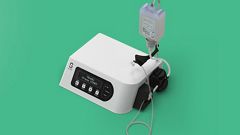
Herausragende ästhetische Ergebnisse.
Periimplantäre Gesundheit.
Als der globale Goldstandard in der Implantologie und der ästhetischen Zahnmedizin engagiert sich Straumann nachdrücklich in der Weiterentwicklung von keramischen Technologien. Dank der urheberrechtlich geschützten Technologien des PURE Systems sind in dem Portfolio Straumann® Ceramic Implantatsysteme mehr als 30 Jahre Forschung, Entwicklung und klinisches Know-how vereint.
Konzipiert für herausragende ästhetische Behandlungsergebnisse bieten beide Systeme die in der modernen Zahnmedizin für digitale und herkömmliche Workflows erwartete Flexibilität, während sie Zahnärzten/-ärztinnen das für die Behandlung ihrer Patienten und Patientinnen notwendige Vertrauen geben.
Hoch ästhetische Ergebnisse und exzellentes Weichgewebemanagement.1,2
Bone Level Implantatsystem aus 100 % Keramik.
Metallfreie Implantate und klinisch bewährte ZLA Oberfläche.6-8
Flexible Behandlungsprotokolle, digitale präoperative Implantatplanung und Guided Surgery.
Erhältlich in verschiedenen Implantatdurchmessern, einschliesslich durchmesserreduziert mit Ø 3,3 mm.
100 % belastungsgeprüft.5

Das Straumann® PURE Ceramic Implantatsystem
Entdecken Sie PURE, das natürliche Weiss. Ein Lächeln zum Verlieben.
Ein gewinnendes Lachen und ein strahlendes Lächeln stehen für Attraktivität, Lebensfreude und Gesundheit. Das PURE Ceramic Implantatsystem zaubert selbst anspruchsvollsten Patienten und Patientinnen ein unbeschwertes Lächeln ins Gesicht. PURE Ceramic ist die Materiallösung für natürliches Aussehen und zuverlässige und ästhetische Versorgungen ohne Kompromisse. Das Straumann® PURE Ceramic Implantatsystem ist das Ergebnis von 12 Jahren unermüdlicher Forschung und Entwicklung und erfüllt unsere höchsten Qualitätsstandards. Es vereint Schweizer Qualität und Präzision, Festigkeit und klinischen Erfolg in einer innovativen Lösung, mit der Sie die anspruchsvollen Bedürfnisse Ihrer Patienten und Patientinnen erfüllen können.

Hoch ästhetische Ergebnisse und exzellentes Weichgewebemanagement.1,2

Leistungsstarke Zirkondioxidkeramik, in rigorosen 100%-Belastungstests geprüft.5,6,9

ZLA® Oberfläche mit revolutionären Osseointegrationseigenschaften.

Flexible Behandlungsprotokolle, digitale präoperative Implantatplanung.

Ein neues System, mit dem Sie neue Patient/innen gewinnen können.10

Eine metallfreie Alternative zu Titan-Implantaten.

Ästhetische Versorgungen: Geben Sie Ihren Patient/innen ihre Lebensfreude und ein strahlendes Lächeln zurück. – Mehr erfahren

Für ein sicheres Gefühl – Mehr erfahren.
Sie suchen weitere Informationen? Sie finden Sie in der Mediathek.

Straumann® PURE Ceramic Implantat Monotype
Mehr als PURE Ästhetik. Die metallfreie Lösung für ein natürliches Erscheinungsbild.
Das Design des Straumann® PURE Ceramic Implantats Monotype basiert auf den erprobten Merkmalen der Straumann® Tissue Level Standard Plus und Straumann® Bone Level Implantatlinien. Zusätzlich zum Standardimplantat mit Ø 4,1 mm steht das durchmesserreduzierte 3,3-mm-Implantat für die besonderen klinischen Anforderungen spezifischer intraoraler Situationen insbesondere im Frontzahnbereich zur Verfügung.
Sie suchen weitere Informationen? Sie finden Sie in der Mediathek.

Straumann® PURE Ceramic Implantat
Mehr als PURE Ästhetik. Die flexible zweiteilige Lösung für ein natürliches Erscheinungsbild.
Die Innenverbindung des Straumann® PURE Ceramic Implantats und die Sekundärteile der Straumann® PURE Ceramic Implantatlinie vereinen zuverlässige Straumann® Qualität mit den hoch ästhetischen Ergebnissen des PURE Implantats.
Sie suchen weitere Informationen? Sie finden Sie in der Mediathek.
Wissenschaftliche Evidenz
Sie suchen nach weiterer wissenschaftlicher Evidenz? Sie finden Sie hier.






